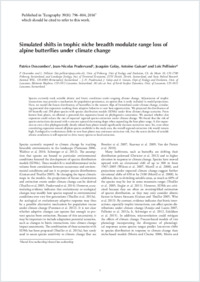Simulated shifts in trophic niche breadth modulate range loss of alpine butterflies under climate change
- Descombes, Patrice Univ. of Fribourg, Unit of Ecology and Evolution, Fribourg, Switzerland - Landscape Ecology, Inst. of Terrestrial Ecosystems, ETH Zürich, Zürich, Switzerland - Swiss Federal Research Institute WSL, Birmensdorf, Switzerland
- Pradervand, Jean-Nicolas Dept of Ecology and Evolution, Univ. of Lausanne, Bâtiment Biophore, Lausanne, Switzerland
- Golay, Joaquim Dept of Ecology and Evolution, Univ. of Lausanne, Bâtiment Biophore, Lausanne, Switzerland
- Guisan, Antoine Dept of Ecology and Evolution, Univ. of Lausanne, Bâtiment Biophore, Lausanne, Switzerland - Inst. of Earth Surface Dynamics, Univ. of Lausanne, Switzerland
- Pellissier, Loïc Univ. of Fribourg, Unit of Ecology and Evolution, Fribourg, Switzerland - Landscape Ecology, Inst. of Terrestrial Ecosystems, ETH Zürich, Zürich, Switzerland - Swiss Federal Research Institute WSL, Birmensdorf, Switzerland
-
01.08.2016
Published in:
- Ecography. - 2016, vol. 39, no. 8, p. 796–804
English
Species currently track suitable abiotic and biotic conditions under ongoing climate change. Adjustments of trophic interactions may provide a mechanism for population persistence, an option that is rarely included in model projections. Here, we model the future distribution, of butterflies in the western Alps of Switzerland under climate change, simulating potential diet expansion resulting from adaptive behavior or new host opportunities. We projected the distribution of 60 butterfly and 298 plant species with species distribution models (SDMs) under three climate change scenarios. From known host plants, we allowed a potential diet expansion based on phylogenetic constraints. We assessed whether diet expansion could reduce the rate of expected regional species extinction under climate change. We found that the risk of species extinctions decreased with a concave upward decreasing shape when expanding the host plant range. A diet expansion to even a few phylogenetically closely related host plants would significantly decrease extinction rates. Yet, even when considering expansion toward all plant species available in the study area, the overall regional extinction risk would remain high. Ecological or evolutionary shifts to new host plants may attenuate extinction risk, but the severe decline of suitable abiotic conditions is still expected to drive many species to local extinction.
- Faculty
- Faculté des sciences et de médecine
- Department
- Département de Biologie
- Language
-
- English
- Classification
- Biological sciences
- License
- License undefined
- Identifiers
-
- RERO DOC 278433
- DOI 10.1111/ecog.01557
- Persistent URL
- https://folia.unifr.ch/unifr/documents/305187
Statistics
Document views: 65
File downloads:
- pell_sst.pdf: 156
